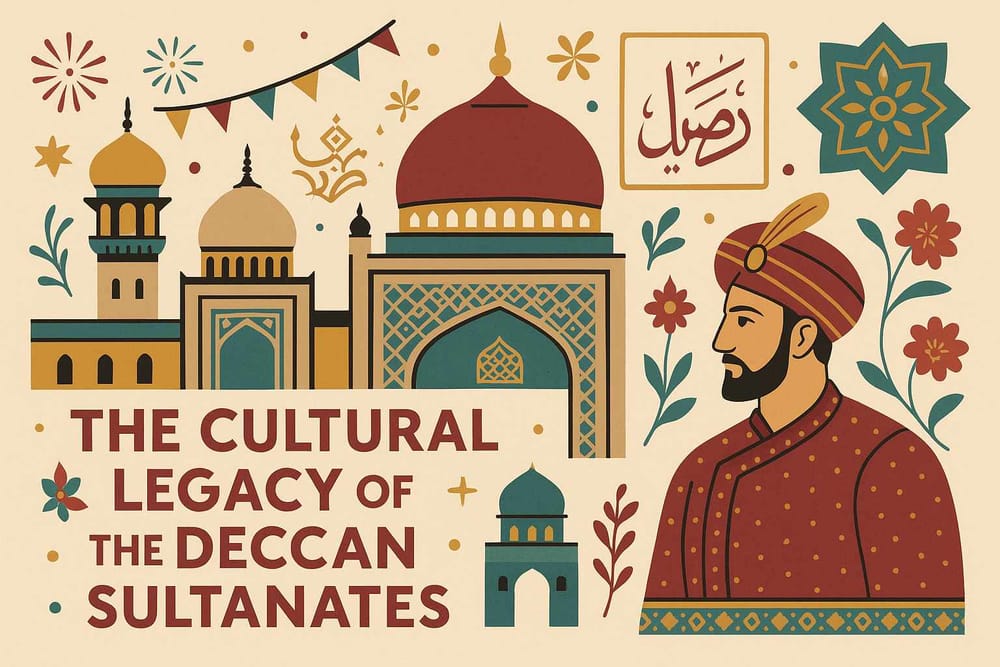
The Cultural Legacy of the Deccan Sultanates: Art-Architecture-Language
Imagine standing in a land where every stone tells a story, where the air itself seems to hum with poetry from centuries past. This is the Deccan plateau, a heartland that has welcomed and woven together countless cultures. Between the 14th and 17th centuries, this region became the canvas for five remarkable dynasties – the Deccan Sultanates. More than just rulers, the kingdoms of Bijapur, Golkonda, Ahmadnagar, Bidar, and Berar were patrons of an extraordinary cultural renaissance, leaving behind a legacy that continues to breathe life into the soul of South India.
Their story isn't just one of battles and politics; it's a beautiful tale of how different worlds can meet to create something entirely new and breathtaking. They masterfully blended the grandeur of Persian and Islamic traditions with the deep-rooted aesthetics of the local land, creating a unique identity that is still celebrated today.
A Canvas of Colour and Calligraphy: The Artistic Soul of the Sultanates
Under the watchful eyes of the Sultans, art didn't just flourish; it found a new language. This was a world where creativity was cherished, and artists were encouraged to dream beyond the conventional, blending diverse styles into a harmonious whole.
- Deccani Miniature Painting: Forget what you know about Mughal realism. The artists of Bijapur and Golconda were on a more inward journey. Their miniature paintings are a world of their own, bursting with brilliant colours, luxurious details, and a touch of the fantastical. These works were less about capturing a perfect likeness and more about evoking a feeling, a mystic mood that transports you to the opulent courts and lush gardens of the time.
- The Sacred Art of Calligraphy: In the Deccan, the written word was an art form of the highest order. Rulers like Ibrahim Adil Shah II of Bijapur were not just patrons but connoisseurs, establishing centres of learning to preserve this craft. Calligraphers blended Persian and Arabic scripts like the elegant Nasta'liq and the majestic Thuluth with local artistic sensibilities, carving divine verses and royal decrees onto monuments and manuscripts that still inspire awe.
- Bidriware - Metal Magic from Bidar: One of the most unique contributions is the stunning metalwork known as Bidriware. Originating in Bidar, this craft involves inlaying intricate silver designs onto a blackened metal alloy. It’s a perfect symbol of the Deccan’s spirit – a beautiful fusion of Persian techniques and Indian craftsmanship, reflecting the region's rich trade history. This dedication to intricate artistry is a common thread in India's diverse heritage, much like the rich traditions of arts and crafts found in Mewar.
Architecture That Touches the Sky: Marvels in Stone and Stucco
The buildings left behind by the Deccan Sultanates are not mere structures; they are conversations in stone. They showcase a spectacular fusion of Indo-Islamic design, where grand domes sit in harmony with delicate Indian motifs, and advanced engineering serves both beauty and purpose.
- Gol Gumbaz – The Whispering Giant: In Bijapur stands the magnificent Gol Gumbaz, home to one of the largest unsupported domes in the world. But its true magic lies within its whispering gallery. A sound whispered at one end can be heard clearly across its massive expanse, a feat of acoustic engineering that feels like pure magic. It stands as a testament to their architectural genius.
- Forts of Ingenuity: The Golkonda and Bidar forts are more than just defensive structures; they are masterpieces of strategic planning. Golkonda's famous acoustic system, where a clap at the entrance could be heard at the highest point, and its brilliant water management systems, showcase an incredible understanding of science and environment.
- A Legacy Recognised by the World: The global significance of this architectural heritage is undeniable. UNESCO has recognised the immense value of these structures, placing the "Monuments and Forts of the Deccan Sultanate" on its tentative list of World Heritage Sites, ensuring their stories are preserved for generations to come.
The Birth of a New Voice: Dakhani, the Language of the Land
Perhaps the most enduring legacy of the Deccan Sultanates is the language they nurtured. While Persian was the language of the court, a beautiful new tongue emerged from the soil of the Deccan, a language that spoke the heart of its people.
This was Dakhani, a unique and melodious blend of Persian and Arabic with the local flavours of Marathi, Kannada, and Telugu. It wasn't just a dialect; it evolved into a rich, independent literary language. Rulers like Muhammad Quli Qutb Shah of Golconda were themselves poets who composed in Dakhani, giving it a royal seal of approval. This language is a living embodiment of the cultural synthesis that defined the era, a sweet reminder of how different streams can flow together to form a mighty river.
The Heart of Their Legacy: A Symphony of Cultures
So, who were these visionaries? The Deccan Sultanates were the five kingdoms that rose after the Bahmani Sultanate, and their true genius lay in their ability to see unity in diversity. They didn't just tolerate local Hindu customs; they embraced and integrated them, creating a harmonious cultural identity that was uniquely Deccani.
This beautiful fusion can still be felt today. It’s in the taste of our biryanis and kebabs, in the celebration of festivals that blend traditions, and in the very fabric of life in cities like Hyderabad, Bijapur, and Aurangabad. The uniqueness of their architecture doesn't just come from domes and minarets but from how seamlessly Islamic geometric patterns merge with local floral designs. They showed the world that harmony creates the most lasting beauty.
At Bhaktilipi, we believe that preserving these legacies is a sacred duty. The stories and artistic traditions of the Deccan Sultanates are a vital part of our collective heritage. We are dedicated to collecting and sharing such timeless devotional and cultural literature, ensuring these treasures remain accessible for everyone to experience and cherish.
Stay connected with our mission to keep India's spiritual and cultural flame burning bright. You can subscribe to our newsletter for more inspiring stories or follow our journey on social media.
Honouring a Timeless Heritage
The legacy of the Deccan Sultanates is a powerful reminder that our strength lies in our ability to embrace different influences and create something new. From the awe-inspiring Gol Gumbaz to the soulful poetry of Dakhani, every creation is a chapter in India’s grand story of cultural fusion.
As we look back at their contributions, we are not just looking at history. We are looking at a blueprint for a harmonious future. Let us celebrate and protect these historical treasures, ensuring that the incredible story of the Deccan Sultanates continues to inspire pride and wonder for all time.
A passionate group of people dedicated to preserving India's knowledge of Dharma, Karma, and Bhakti for ourselves and the world 🙏.
